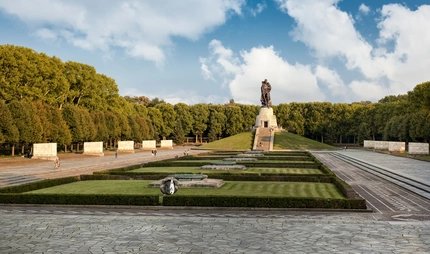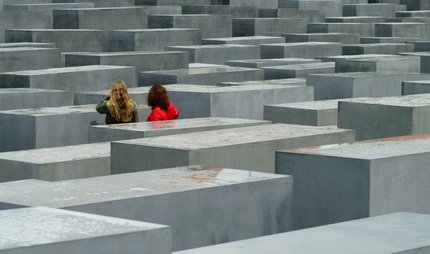
Soviet Memorial Tiergarten
A memorial to more than 2000 Red Army soldiers
A place of remembrance in the centre of Berlin: the Soviet War Memorial on Straße des 17. Juni commemorates the fallen soldiers.
The Brandenburg Gate is top of everyone’s list of sights to see in Berlin, and the Reichstag is also bound to be on it. Between them on Straße des 17. Juni you can stop and see an important piece of Berlin’s history at the Soviet War Memorial in the Tiergarten.
It is estimated that 80,000 Soviet troops lost their lives in 1945 fighting to take Berlin. There are three memorials in the city to commemorate them: one in Treptower Park, one in Schönholzer Heide and this one in Tiergarten. The Soviet War Memorial in Tiergarten was the first to be built and was dedicated on 11 November 1945. The site was designed by the sculptors Lev Kerbel und Vladimir Tsigal and the architect Nikolai Sergiyevski.
The design of the Soviet War Memorial in Tiergarten
You enter the war memorial via its main entrance on Straße des 17. Juni. It is symmetrically laid out, flanked on the left and right by two Soviet T-34 tanks that were the first to reach Berlin. Diagonally behind them are two artillery guns recalling the battle for Berlin. Their salvoes marked the victory over the Nazis. At the centre of the memorial are colonnades bearing the names of the fallen soldiers. The large Russian inscription is translated as “Eternal glory to heroes who fell in battle with the German fascist invaders for the freedom and independence of the Soviet Union. 1941–1945”.
The highest pillar at the centre of the colonnades bears an eight-metre-tall statue of a Red Army soldier. His rifle is slung over his shoulder to signify that the war is over. He holds his left hand over the graves of more than 2000 soldiers. The cemetery is a green lawn behind the colonnades.
The six-hectare site is not the only memorial in and around the Tiergarten. The Holocaust Memorial, the memorial to homosexuals persecuted by the Nazis and the memorial to the Sinti and Roma victims of the Holocaust are all close by and together form a moving reminder of the dark side of Berlin’s history.



